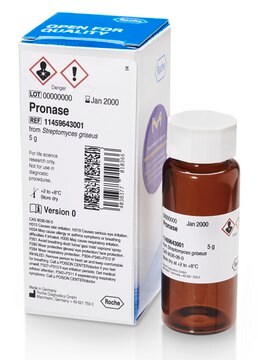L6132
L-Lysine–Agarose
lyophilized powder
Iniciar sesiónpara Ver la Fijación de precios por contrato y de la organización
About This Item
Productos recomendados
Formulario
lyophilized powder
Nivel de calidad
Extensión del etiquetado
~4 μmol per mL
técnicas
affinity chromatography: suitable
Matriz
Sepharose 4B
activación de la matriz
cyanogen bromide
unión a la matriz
α-amino
espaciador de matriz
1 atom
idoneidad
suitable for chromatography
temp. de almacenamiento
2-8°C
¿Está buscando productos similares? Visita Guía de comparación de productos
Aplicación
L-lysine-agarose is used in protein chromatography, affinity chromatography and amino acid resins. L-lysine-agarose has been used to study mitogen-activated protein kinase (MAPK) cascades in abscisic acid (ABA) signal transduction pathways as well as to study the regulation of phosphorylation of tau protein in the brain.
Forma física
Lyophilized powder stabilized with lactose and dextran
Producto relacionado
Referencia del producto
Descripción
Precios
Código de clase de almacenamiento
11 - Combustible Solids
Clase de riesgo para el agua (WGK)
WGK 3
Punto de inflamabilidad (°F)
Not applicable
Punto de inflamabilidad (°C)
Not applicable
Equipo de protección personal
Eyeshields, Gloves, type N95 (US)
Elija entre una de las versiones más recientes:
¿Ya tiene este producto?
Encuentre la documentación para los productos que ha comprado recientemente en la Biblioteca de documentos.
P Saxena et al.
Investigative ophthalmology & visual science, 41(6), 1473-1481 (2000-05-08)
With age, human lens crystallins become more pigmented, oxidized, modified by ascorbate oxidation and advanced glycation end products (AGEs), and bind copper. The hypothesis was tested that the major AGE and ascorbylation product in the human lens, N(epsilon)-carboxymethyl-L-lysine (CML), has
V J Christiansen et al.
Arteriosclerosis, thrombosis, and vascular biology, 17(1), 164-171 (1997-01-01)
Deposition of the terminal complement proteins (C5b-9) on human endothelial cells can result in cell lysis or nonlytic alterations of cell function including procoagulant responses. Because regulation of fibrinolysis is a central endothelial function and because C9 contains a carboxyl-terminal
M B Furie et al.
Journal of cell science, 88 ( Pt 2), 161-175 (1987-09-01)
Monolayers of bovine microvascular endothelial cells (BMECs) grown on connective tissue derived from human amniotic membrane were used to examine the transendothelial migration of human neutrophils in vitro. Neutrophils placed above these cultures migrated in response to a chemotactic gradient
H H Nguyen et al.
The Journal of biological chemistry, 273(14), 7957-7966 (1998-05-09)
The particulate methane monooxygenase (pMMO) is known to be very difficult to study mainly due to its unusual activity instability in vitro. By cultivating Methylococcus capsulatus (Bath) under methane stress conditions and high copper levels in the growth medium, membranes
J Tao et al.
Proceedings of the National Academy of Sciences of the United States of America, 89(7), 2723-2726 (1992-04-01)
A single arginine residue within the basic region of the human immunodeficiency virus Tat protein mediates specific binding of Tat peptides to a three-nucleotide bulge in TAR RNA. It has been proposed that arginine recognizes TAR by forming a network
Nuestro equipo de científicos tiene experiencia en todas las áreas de investigación: Ciencias de la vida, Ciencia de los materiales, Síntesis química, Cromatografía, Analítica y muchas otras.
Póngase en contacto con el Servicio técnico






